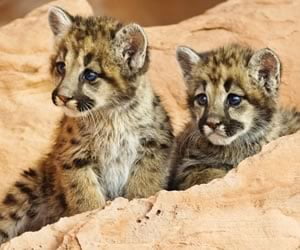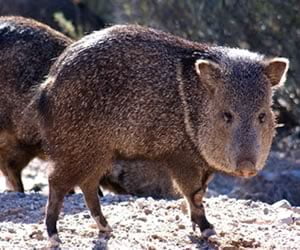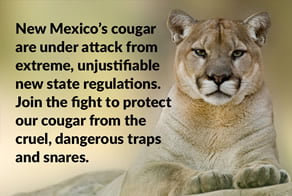Destruction of Protected and Endangered Species
Trouble for Protected and Endangered Species
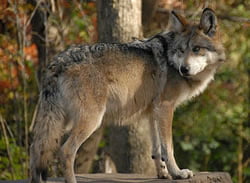
- New Mexico Department of Game and Fish (NMDGF) imposes no limits on how many animals like bobcats or foxes can be killed by licensed trappers.
- NMDGF has not established hunting zones, so heavily trapped subpopulations can be completely wiped out, or extirpated.
- New Mexico has conducted few wildlife population studies. No one knows how many animals trapped for their fur existed in the past or live in the present.
- New Mexico regulations fail to account for, and mitigate against pressures on wildlife populations when pelt prices are high.
- Many of New Mexicos native carnivores, including endangered species and protected furbearers such as coatimundis and river otters, are vulnerable to traps, which are inherently indiscriminate.
Endangered Mexican Wolves
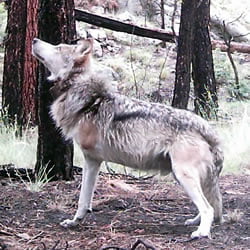
Endangered Mexican wolves continue to be caught in traps legally set under New Mexico regulations.
Endangered Mexican wolves continue to be caught in traps legally set under New Mexico regulations.
At the end of 2010, only 50 Mexican gray wolves (and two breeding pairs) roamed in the wild. Mexican wolves or lobos are one of the most endangered species on the planet, and the most endangered North American land mammal, yet trapping continues on their lands.
Non-governmental trappers have trapped at least fourteen lobos since 2002. Many sustained injuries including the loss of toes, and two wolves had legs fully amputated as a result of injuries sustained from traps.
In July 2010, Governor Richardson banned traps in the Blue Range Mexican Wolf Recovery Area. In November 2010, the Game Commission unanimously ratified that decision, but the NMDGF defied the Governor and the Commission. The agency allowed coyote trapping to continue on the Blue Range Wolf Recovery area, arguing disingenuously that it had no authority to regulate coyote trapping.
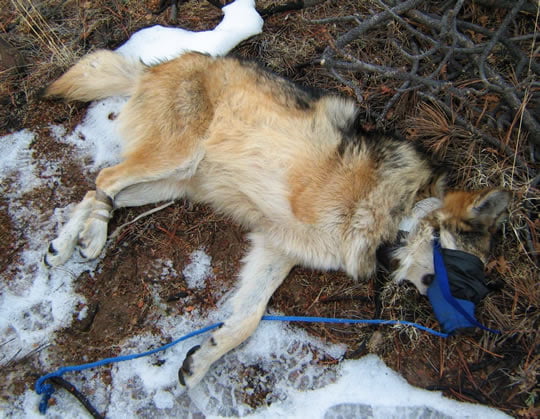
This endangered Mexican wolf required amputation of a front limb due to trap injury.
Bobcats
 New Mexico supplied a jaw-dropping 22,961 bobcat furs to the world’s fur market in the last decade. NMDGF counts bobcats pursuant to the Convention on International Trade of Endangered Species (CITES). Despite the fact that New Mexico is required by CITES to ensure that it does not cause detriment to the survival of bobcats, it has one of the longest bobcat seasons in the west and no bag limits. Its population size has been grossly overestimated by NMDGF, said one biologist, who analyzed NMDGF’s records and study methodologies.
New Mexico supplied a jaw-dropping 22,961 bobcat furs to the world’s fur market in the last decade. NMDGF counts bobcats pursuant to the Convention on International Trade of Endangered Species (CITES). Despite the fact that New Mexico is required by CITES to ensure that it does not cause detriment to the survival of bobcats, it has one of the longest bobcat seasons in the west and no bag limits. Its population size has been grossly overestimated by NMDGF, said one biologist, who analyzed NMDGF’s records and study methodologies.
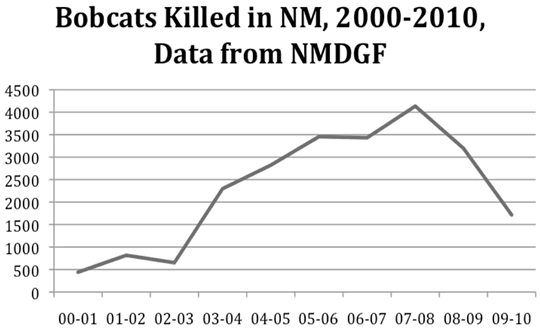
The graph above shows a precipitous decline in the number of bobcats trapped since 2007-2008. Bobcat furs can still fetch hundreds of dollars per pelt. Demand is high, but the catch was low. Is NMDGF allowing trappers to overexploit bobcats?
Lynx
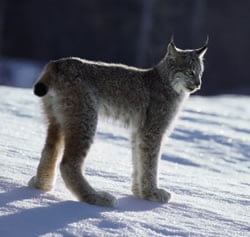 Lynx were all but eliminated from the Southern Rockies due to trapping, shooting, and habitat degradation.
Lynx were all but eliminated from the Southern Rockies due to trapping, shooting, and habitat degradation.
Since lynx were successfully reintroduced into Colorado, many have moved into the forests of northern New Mexico, where unabated trapping is allowed. Historically lynx were easily trapped and poisoned and this lead to their decline.
Lynx are often caught in traps and snares intended for coyotes. New Mexico denies that lynx are present in the State, despite the fact that GPS information from Colorado Division of Wildlife confirms it.
More Protected and Endangered Species
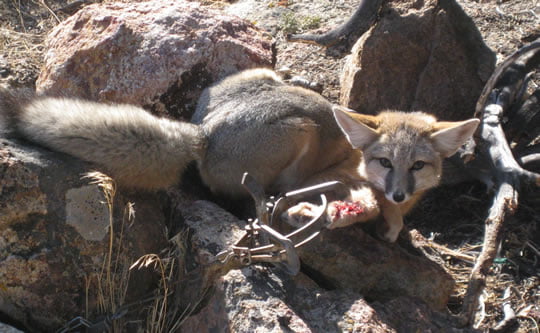
Despite their precariously low numbers, swift foxes are still trapped even as their pelts are practically worthless on global fur markets.
 Know Your NM State Legislators!
Know Your NM State Legislators!
Your New Mexico state Senator and Representative have the power to ban traps, snares and poisons on public lands. Find out who they are and let them know you oppose trapping on public lands. A simple phone call and email can make all the difference.
People's Forum Panel Report on Public Lands Trapping
The New Mexico Legislature should ban trapping on public lands in New Mexico because traps harm people, animal companions, and whole populations of wildlife including rare species. Most New Mexican voters believe that trapping is cruel and unnecessary.
TrapFree Friends
Animal Protection Voters
Black Bear Bureau
Footloose Montana
Fur Free Alliance
Furbearer Defenders
League of Humane Voters
Lobos of the Southwest
Mercy for Animals
National Urban Wildlife Coalition
No Cruel Traps on Public Lands
People's Forum Panel on New Mexico Public Lands Trapping
Predator Defense
Project Coyote
Pulling for Life
TrailSafe Nevada
Trap Free Montana
TrapFree Oregon
Wyoming Untrapped



